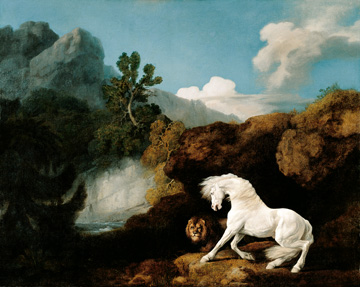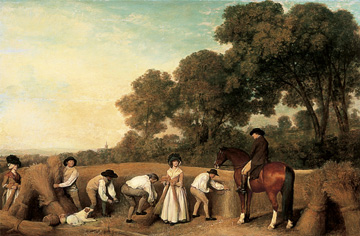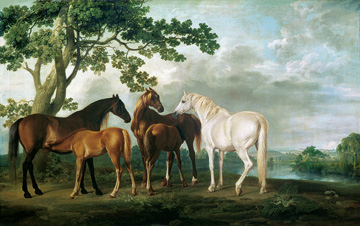
(845) 246-6944
· info@ArtTimesJournal.com
 “Haymakers” 1785 (Oil on Wood) |
By
RAYMOND J. STEINER
MOUNTED
IN COMMEMORATION of George Stubbs? bicentenary, this exhibition* —
which has come to its New York venue at The Frick Collection via two
earlier presentations at the Walker Art Gallery (Liverpool) and at
Tate Britain (London) — offers a selection of seventeen paintings
that showcase that artist?s range of works from his early portraits
to his much celebrated
Not
that Stubbs? reputation as a fine painter of horses is overstated
— as an exhibition organized by the Kimbell Art Museum in Fort
Worth, Texas in 2004-05 gave ample evidence.
 “A Horse Frightened by a Lion” 1770 (Oil on Canvas) |
Robin
Blake accompanying the exhibition — gave over a third of its
space to a showing of Stubbs? anatomical studies of the horse, a series
he executed between the years 1746 and 1752 when he spent time in
the dissection of them and which culminated in his publishing of the
well-received The Anatomy of the Horse in 1766. An autodidact,
George Stubbs managed to attain a considerable amount of respect as
a painter — becoming an academician at The Royal Academy and
counting royalty among his many patrons — on the basis of his
ability to render his subjects with near-scientific precision. Thus,
his reputation as the painter of horses was well merited.
 “Reapers” 1785 (Oil on Wood) |
moose
and a monkey — but so also are human figures and landscape.
If we can only judge him by his reapers and haymakers in this particular
exhibition there seems little to quibble with as to his skillful handling
of the human form. As for landscape, although largely serving as backdrops,
his treatment of hills, fields, clouds, and streams — see, for
example, his masterful clouds in almost all of his works and the painterly
handling of the highlights on water (a particularly difficult subject
in any medium) in
 “Mares and Foals in a River Landscape” c. 1763-8 (Oil on Canvas) |
Stubbs
was also adept at painting a convincing townscape — adding as
simple
You
won?t regret a trip to The Frick to take in and relish this early
master.
*